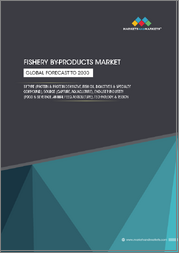
|
시장보고서
상품코드
1775665
대구 시장 규모, 점유율, 성장 분석 : 유형별, 공급원별, 제품 유형별, 유통 채널별, 지역별 - 산업 예측(2025-2032년)Cod Fish Market Size, Share, and Growth Analysis, By Species (Atlantic Cod Fish, Pacific Cod Fish), By Sources (Farmed, Wild Capture), By Product Types, By Distribution Channels, By Region - Industry Forecast 2025-2032 |
||||||
세계의 대구 시장 규모는 2023년에 113억 달러로 평가되며, 2024년 120억 3,000만 달러에서 2032년에는 199억 2,000만 달러로 성장하며, 예측 기간(2025-2032년)의 CAGR은 6.5%로 성장할 전망입니다.
세계 대구 시장은 수산물 수요 증가와 식품 산업의 확대로 인해 강력한 성장세를 보이고 있습니다. 1인당 소득 증가와 더불어 많은 국가에서 생선 생산량이 증가하면서 시장 확대에 힘을 실어주고 있습니다. 고단백질과 오메가 3 지방산을 함유한 대구의 영양학적 특성이 소비자의 건강 지향적 성향에 부합하는 한편, 수산업은 전 세계 대량 생산 수요를 충족시키기 위해 진화하고 있습니다. 특히 보디빌딩 분야에서는 어유가 선호되어 수요가 증가하고 있습니다. 또한 소나, GPS, 양식업의 발전과 같은 기술 혁신은 지속가능한 관행과 안정적인 공급을 보장합니다. 콜드체인 물류는 또한 간편 조리식품을 포함한 부가가치 제품 개발을 가능하게 하여 건강 지향적이고 편리함을 추구하는 소비자들에게 어필할 수 있습니다.
목차
서론
- 조사의 목적
- 조사 범위
- 정의
조사 방법
- 정보 조달
- 2차·1차 데이터 방법
- 시장 규모 예측
- 시장의 전제조건과 제한
개요
- 세계 시장 전망
- 공급과 수요 동향 분석
- 부문별 기회 분석
시장 역학과 전망
- 시장 개요
- 시장 규모
- 시장 역학
- 촉진요인과 기회
- 억제요인과 과제
- Porter의 산업 분석
주요 시장 인사이트
- 주요 성공 요인
- 경쟁의 정도
- 주요 투자 기회
- 시장 에코시스템
- 시장의 매력 지수(2024년)
- PESTEL 분석
- 거시경제 지표
- 밸류체인 분석
- 가격 분석
- 사례 연구
- 고객 구매 행동 분석
대구 시장 규모 : 유형별 & CAGR(2025-2032년)
- 시장 개요
- 대서양 대구
- 태평양 대구
- 그린란드 대구
- 기타
대구 시장 규모 : 공급원별 & CAGR(2025-2032년)
- 시장 개요
- 양식
- 야생 포획
대구 시장 규모 : 제품 유형별 & CAGR(2025-2032년)
- 시장 개요
- 신선
- 통조림
- 냉동
- 기타
대구 시장 규모 : 유통 채널별 & CAGR(2025-2032년)
- 시장 개요
- 상업용
- 소매
- 직접 판매
- 슈퍼마켓·하이퍼마켓
- 온라인 스토어
- 기타
대구 시장 규모 : 지역별 & CAGR(2025-2032년)
- 북미
- 미국
- 캐나다
- 유럽
- 독일
- 스페인
- 프랑스
- 영국
- 이탈리아
- 기타 유럽 지역
- 아시아태평양
- 중국
- 인도
- 일본
- 한국
- 기타 아시아태평양
- 라틴아메리카
- 브라질
- 기타 라틴아메리카 지역
- 중동 및 아프리카
- GCC 국가
- 남아프리카공화국
- 기타 중동 및 아프리카
경쟁 정보
- 상위 5사의 비교
- 주요 기업의 시장 포지셔닝(2024년)
- 주요 시장 기업이 채택한 전략
- 최근 시장 동향
- 기업의 시장 점유율 분석(2024년)
- 주요 기업의 기업 개요
- 기업의 상세
- 제품 포트폴리오 분석
- 기업의 부문별 점유율 분석
- 매출의 전년대비 비교(2022-2024년)
주요 기업 개요
- Marine Harvest(Norway)
- AquaChile(Chile)
- Ice Fish AS(Norway)
- Norway Royal Salmon ASA(Norway)
- Alliance Seafood AS(Norway)
- Leroy Seafood AS(Norway)
- Norsk Sjomat AS(Norway)
- Nordic Sea Farm(Norway)
- Cooke Aquaculture(Canada)
- Trident Seafoods(USA)
결론과 제안
KSA 25.07.31Global Cod Fish Market size was valued at USD 11.3 billion in 2023 and is poised to grow from USD 12.03 billion in 2024 to USD 19.92 billion by 2032, growing at a CAGR of 6.5% during the forecast period (2025-2032).
The global cod fish market is witnessing robust growth fueled by rising seafood demand and the expansion of the food industry. Increasing fish production across numerous countries, coupled with higher per capita income, bolsters market expansion. The fisheries industry is evolving to satisfy global needs for substantial production, while the nutritional profile of cod fish featuring high protein and omega-3 fatty acids aligns with the growing consumer health consciousness. In particular, the bodybuilding sector's preference for fish oil enhances demand. Moreover, technological innovations such as sonar, GPS, and aquaculture advancements ensure sustainable practices and stable supply. Cold chain logistics further enable the development of value-added products, including convenient ready-to-cook meals, appealing to health-oriented and convenience-seeking consumers.
Top-down and bottom-up approaches were used to estimate and validate the size of the Global Cod Fish market and to estimate the size of various other dependent submarkets. The research methodology used to estimate the market size includes the following details: The key players in the market were identified through secondary research, and their market shares in the respective regions were determined through primary and secondary research. This entire procedure includes the study of the annual and financial reports of the top market players and extensive interviews for key insights from industry leaders such as CEOs, VPs, directors, and marketing executives. All percentage shares split, and breakdowns were determined using secondary sources and verified through Primary sources. All possible parameters that affect the markets covered in this research study have been accounted for, viewed in extensive detail, verified through primary research, and analyzed to get the final quantitative and qualitative data.
Global Cod Fish Market Segments Analysis
Global Cod Fish Market is segmented by Species, Sources, Product Types, Distribution Channels and region. Based on Species, the market is segmented into Atlantic Cod Fish, Pacific Cod Fish, Greenland Cod Fish and Others. Based on Sources, the market is segmented into Farmed and Wild Capture. Based on Product Types, the market is segmented into Fresh, Canned, Frozen and Others. Based on Distribution Channels, the market is segmented into Institutional and Retail. Based on region, the market is segmented into North America, Europe, Asia Pacific, Latin America and Middle East & Africa.
Driver of the Global Cod Fish Market
The global cod fish market is driven by the increasing awareness of health and nutrition among consumers, particularly in urban regions where individuals tend to have higher disposable incomes. Cod is celebrated for its high protein and low-fat content, positioning it as a nutritious seafood option that appeals to health-conscious eaters. Its versatility in cooking allows it to easily integrate into various diets, further enhancing its popularity. Additionally, the emergence of ready-to-eat cod products caters to the fast-paced lifestyles of urban dwellers, making it a preferred choice for those seeking convenient yet healthy meal options.
Restraints in the Global Cod Fish Market
The Global Cod Fish market faces significant constraints due to the overexploitation of traditional fishing grounds, leading to severely depleted wild cod populations. To maintain ecological balance, stringent fishing regulations are implemented by both international governing bodies and individual nations that own fishing fleets. These conservation initiatives, while necessary for sustainability, further reduce the already limited availability of wild-caught cod. As a result, costs begin to rise, creating a challenging scenario where the market struggles to satisfy the increasing consumer demand consistently over time. This situation places considerable pressure on both suppliers and buyers in the cod fish market.
Market Trends of the Global Cod Fish Market
The global cod fish market is witnessing a notable trend driven by the rising demand for frozen and processed cod products. As consumers prioritize convenience and efficiency in their food choices, the appeal of frozen cod has surged due to its extended shelf life and quick preparation time, aligning well with modern, fast-paced lifestyles. Manufacturers are responding to this trend by expanding their offerings with a diverse range of frozen cod options, including fish fillets, fish fingers, and ready-to-cook meals that not only promise delicious and nutritious dining experiences but also cater to the need for healthy, quick solutions for weekday dinners.
Table of Contents
Introduction
- Objectives of the Study
- Scope of the Report
- Definitions
Research Methodology
- Information Procurement
- Secondary & Primary Data Methods
- Market Size Estimation
- Market Assumptions & Limitations
Executive Summary
- Global Market Outlook
- Supply & Demand Trend Analysis
- Segmental Opportunity Analysis
Market Dynamics & Outlook
- Market Overview
- Market Size
- Market Dynamics
- Drivers & Opportunities
- Restraints & Challenges
- Porters Analysis
- Competitive rivalry
- Threat of substitute
- Bargaining power of buyers
- Threat of new entrants
- Bargaining power of suppliers
Key Market Insights
- Key Success Factors
- Degree of Competition
- Top Investment Pockets
- Market Ecosystem
- Market Attractiveness Index, 2024
- PESTEL Analysis
- Macro-Economic Indicators
- Value Chain Analysis
- Pricing Analysis
- Case Studies
- Customer Buying Behavior Analysis
Global Cod Fish Market Size by Species & CAGR (2025-2032)
- Market Overview
- Atlantic Cod Fish
- Pacific Cod Fish
- Greenland Cod Fish
- Others
Global Cod Fish Market Size by Sources & CAGR (2025-2032)
- Market Overview
- Farmed
- Wild Capture
Global Cod Fish Market Size by Product Types & CAGR (2025-2032)
- Market Overview
- Fresh
- Canned
- Frozen
- Others
Global Cod Fish Market Size by Distribution Channels & CAGR (2025-2032)
- Market Overview
- Institutional
- Retail
- Direct Sales
- Supermarkets and Hypermarkets
- Online Stores
- Others
Global Cod Fish Market Size & CAGR (2025-2032)
- North America (Species, Sources, Product Types, Distribution Channels)
- US
- Canada
- Europe (Species, Sources, Product Types, Distribution Channels)
- Germany
- Spain
- France
- UK
- Italy
- Rest of Europe
- Asia Pacific (Species, Sources, Product Types, Distribution Channels)
- China
- India
- Japan
- South Korea
- Rest of Asia-Pacific
- Latin America (Species, Sources, Product Types, Distribution Channels)
- Brazil
- Rest of Latin America
- Middle East & Africa (Species, Sources, Product Types, Distribution Channels)
- GCC Countries
- South Africa
- Rest of Middle East & Africa
Competitive Intelligence
- Top 5 Player Comparison
- Market Positioning of Key Players, 2024
- Strategies Adopted by Key Market Players
- Recent Developments in the Market
- Company Market Share Analysis, 2024
- Company Profiles of All Key Players
- Company Details
- Product Portfolio Analysis
- Company's Segmental Share Analysis
- Revenue Y-O-Y Comparison (2022-2024)
Key Company Profiles
- Marine Harvest (Norway)
- Company Overview
- Business Segment Overview
- Financial Updates
- Key Developments
- AquaChile (Chile)
- Company Overview
- Business Segment Overview
- Financial Updates
- Key Developments
- Ice Fish AS (Norway)
- Company Overview
- Business Segment Overview
- Financial Updates
- Key Developments
- Norway Royal Salmon ASA (Norway)
- Company Overview
- Business Segment Overview
- Financial Updates
- Key Developments
- Alliance Seafood AS (Norway)
- Company Overview
- Business Segment Overview
- Financial Updates
- Key Developments
- Leroy Seafood AS (Norway)
- Company Overview
- Business Segment Overview
- Financial Updates
- Key Developments
- Norsk Sjomat AS (Norway)
- Company Overview
- Business Segment Overview
- Financial Updates
- Key Developments
- Nordic Sea Farm (Norway)
- Company Overview
- Business Segment Overview
- Financial Updates
- Key Developments
- Cooke Aquaculture (Canada)
- Company Overview
- Business Segment Overview
- Financial Updates
- Key Developments
- Trident Seafoods (USA)
- Company Overview
- Business Segment Overview
- Financial Updates
- Key Developments

















